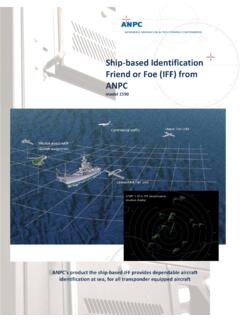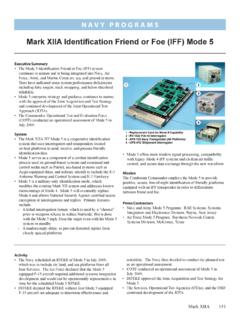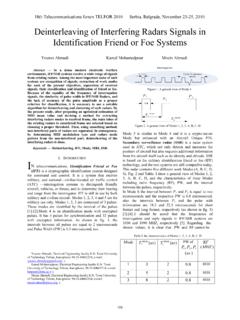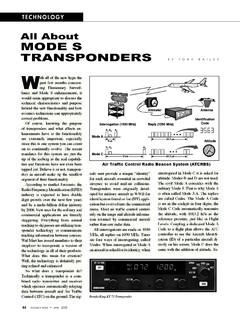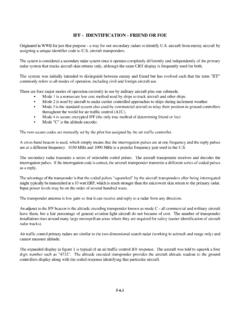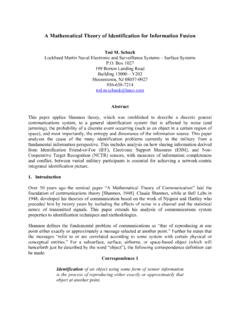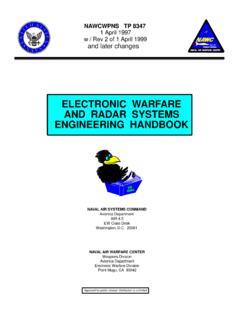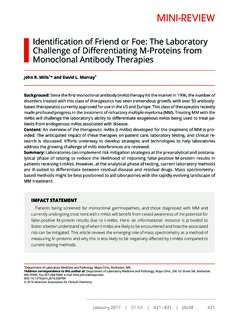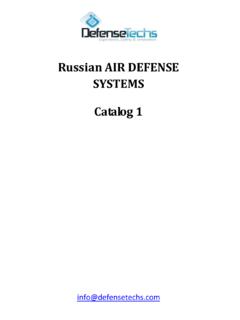Transcription of IFF and Mode 5: Past Present and Future - Tel-Instrument
1 IFF and mode 5 : past Present and Future Written by Chris Allen IFF ( identification Friend or Foe) is the military designation of the Air Traffic Control (ATC). System that is used to identify and track military aircraft. The IFF system consists of an airborne transponder and a ground (or airborne) interrogator. The system measures the distance and heading to the aircraft, and the transponder encodes identification and position information into the response. IFF Mode 5 is the most recent implementation of the system. The IFF systems data capabilities startedwith a single identification number in the 1940s, and was expanded to include altitude reporting and cryptographically secure identification in the 1960s.
2 This design was referred to as the Mark XII standard and incorporated Mode 4 IFF. technologywhich remains the current standard for and NATO countries. The 1980s saw the introduction of Mode S, which allows aircraft specific selective data communications added to support additional air traffic data and the airborne collision avoidance system. The development of the new military IFF ( identification Friend or Foe) system commenced in 1995 when the United States Joint Chiefs of Staff ordered the development of a new waveform (. Mode 5. ) to replace the current Mark XII Mode 4 IFF system. In 2002, NATO ratified STANAG. (Standardization Agreement) 4193 which adopted the Mark XIIA IFF standard for the and NATO.
3 The new Mark XIIA Mode 5 waveform represents the Future standard for all military transponders and interrogators used by NATO countries. The Mode 5 waveform uses modern modulation, coding, and cryptographic techniques to overcome performance and security limitations in the current Mark XII waveform. Additionally, Mode 5 systems provide expanded data handling capabilities tosecurely pass GPS position and other extended data. The new system uses interference reducing spread spectrum techniques which allow the additional data transmissions to be overlaid on the existing ATC system frequencies without increased interference. All legacy modes and Mode 4 operational capability will be retained in order to facilitate an orderly transition to the new Mode 5 IFF waveform.
4 1/2. IFF and mode 5 : past Present and Future Written by Chris Allen The Navy has been leading this transition project along with the assistance of a multi-national working group representing NATO. The Navy, acting as the LPO (Lead Program Office) for the DOD (Department of Defense), has been the driving force in the for the development of Mode 5 technology. In addition to being the LPO, the Navy has been tasked with communicating the progress andschedule to all potential Stakeholders within the military. This has been accomplished through quarterly Stakeholders meetings sponsored and held by the Navy. The new Mode 5 interrogators and transponders have been in development for the last six years with companiesincluding BAE, Raytheon, and Telephonics, all producing Mode 5 systems for use on military aircraft ( , AN/APX-119 and AN/APX-123).
5 BAE and Raytheon also produce Mode 5 cryptographic appliqus that store the secret keys and will be used to support flight-line testing of the aircraft systems. BAE is manufacturing a KIV 78 crypto appliqu and Raytheon is manufacturing a KIV 77 crypto appliqu. The Mode 5 interrogators, transponders, and test support equipment are now entering pilot production and the military is now in the system integration and technical evaluation stage for the new systems and test support equipment. Tel Instrument Electronics Corp. (TIC), a leader in flight-line avionics test equipment, has been working closely with BAE and Raytheon to design flight-line test equipment to verify the operation of the new Mark XIIA Mode 5 IFF systems.
6 In 2005, TIC received a contract from the Navy to design and produce two different Mode 5 flight-line test sets (AN/USM-708 and AN/USM-719). Tel is also producing a TR-420 Mode 5 test set that is now available for shipment to military customers in the United States. The transition to the new Mark XIIA Mode 5 avionics equipment and support equipment is now in process and will entail a major effort for the military and all participating NATO countries over the next 10-15 years. TIC is proud to be a part of this milestone avionics system development effort. 2/2.
